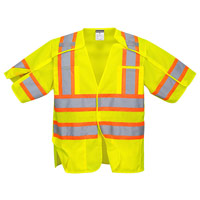Work Clothing - Essential for Safety
Work clothing, also known as personal protective equipment (PPE), is essential for the safety and health of employees in various industries. These garments are designed to protect workers from hazards such as chemical spills, electrical hazards, extreme temperatures, and more.
OSHA Standards and Guidelines
OSHA (Occupational Safety and Health Administration) sets standards for PPE in the United States and requires employers to provide PPE to their employees when necessary. Employers are also required to train employees on the proper use and care of PPE.
Different types of PPE include:
- Hard hats for head protection
- Safety glasses and goggles for eye protection
- Gloves for hand protection
- Face shields for face protection
- Respirators for respiratory protection
- High-visibility clothing for increased visibility in low-light conditions
- Flame-resistant clothing for protection against fire hazards
It is important to note that PPE must be appropriate for the specific job and hazards present in the workplace. For example, a worker handling chemicals will need PPE made from materials that can resist chemical exposure, while a construction worker may need PPE that can withstand falling debris.
It is also important to keep PPE in good condition and replace it as needed. Employers should establish a program to inspect, maintain, and replace PPE as necessary.
In addition to OSHA guidelines, industry-specific organizations may also have their own standards and recommendations for PPE. Employers should be familiar with these standards and ensure that their PPE meets or exceeds them.
Type O – (“Off-Road”) Occupational HVSA for Non-Roadway Use
 Environments which pose stuck-by hazards from moving vehicles, equipment and machinery, but will not include expose to traffic on public access highway rights-of-way or roadway temporary traffic control (TTC) zones.
Environments which pose stuck-by hazards from moving vehicles, equipment and machinery, but will not include expose to traffic on public access highway rights-of-way or roadway temporary traffic control (TTC) zones.
Type R – (“Roadway”) Occupational HVSA for Roadway Use
Environments which include exposure to traffic (vehicles using the highway for purposes of travel) from public access highway rights-of-way, or roadway TTC zones or from work vehicles and construction equipment within a roadway TTC zone
Type P – (“Public Safety”) Occupational HVSA for Emergency and Incident Responders and Law Enforcement Personnel
Be Responsible for Employee Safety
In summary, work clothing or PPE is essential for the safety and health of employees in various industries. Employers are responsible for providing appropriate PPE to their employees and ensuring that it is properly used and maintained. Standards are set by OSHA and other industry-specific organizations, and employers should familiarize themselves with these standards and ensure that their PPE meets or exceeds them.
Recent Posts
-
The Evolution of Safety Clothing, PPE, and Job Safety Standards
At Safety Smart Gear, the nation’s most trusted online store for protective apparel, we know t …Jun 16th 2025 -
Custom Safety Clothing Printing Options
Custom Safety Clothing Printing: Screen Printing & Heat Press Options When it comes to safety cl …May 13th 2025 -
Made In USA Safety Clothing
Benefits of Made in USA Safety Clothing Making Safe Choices with USA-Made Safety Clothing When …Apr 14th 2025




